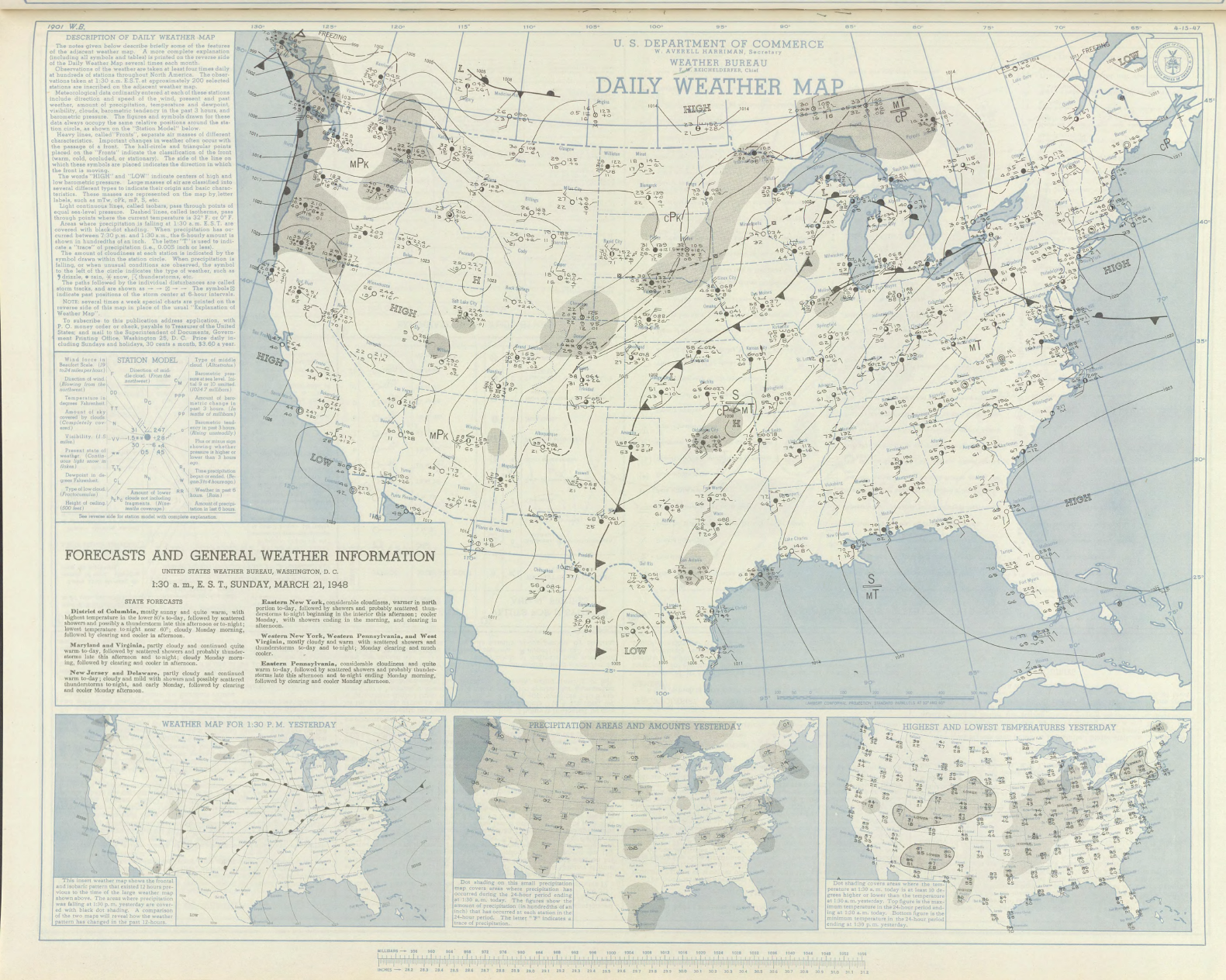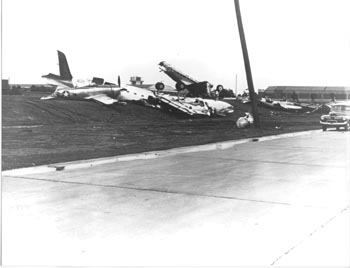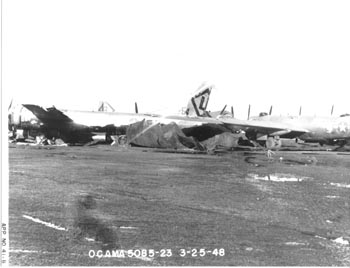
Pacific moisture will continue to bring locally heavy coastal/lower elevation rain and heavy mountain snow to the West Coast and portions of the Intermountain West through Monday. A wintry mix will create hazardous travel across the northern Plains and Upper Midwest into early Monday. Dry, gusty winds are resulting in elevated to critical fire weather in the south/central High Plains. Read More >
Central Oklahoma was visited by destructive tornadoes during the latter part of March 1948. Two of these tornadoes struck the Tinker Air Force Base (AFB) on March 20th and March 25th. A short summary of these two tornadoes follows:
On March 20, 1948, a tornado touched down near the Will Rogers Field (World Airport) in Oklahoma City and moved eastward. The tornado moved across Will Rogers Field and eventually Tinker Air Field (AFB). Extensive damage occurred to buildings and aircraft, mainly at Tinker AFB where 54 aircraft were destroyed, including 17 C-54 transports valued at $500,000 apiece. Also destroyed were 15 P-47 fighters and two B-29 bombers. About 50 other planes were damaged and about 100 vehicles were damaged or destroyed. Three of the 8 injuries attributed to the storm were in the control tower at the base. The tornado produced record amount of damage to that date in Oklahoma. This event prompted the first efforts in tornado forecasting - a milestone made even more interesting 5 days later when the first tornado forecast ever made actually verified at the same location.
On March 25, 1948, another tornado developed near Tinker Air Field (AFB) and moved to the northeast across the Air Force Base, bringing more destruction for the second time in less than a week. This tornado struck just 100 yards from previous tornado's path. A total of 84 planes were hit, 35 of which were destroyed. These included 18 B-29s, 8 P-47s, 20 P-17s, and 3 C-47s. Hangars and other buildings were destroyed. This tornado was described as a "white finger" rather than the "black funnel" of March 20, 1948. The likelihood of tornadoes in the area was forecast successfully for the first time ever, using new methods devised by Air Force forecasters after the tornado event of five days earlier. The Air Force officers that issued this forecast were Lieutenant Colonel Ernest J. Fawbush and Captain Robert C. Miller.
Please use the "Fast Facts" tab to access data, summaries, and reports related to the late March 1948 Tinker AFB tornadoes and the first tornado forecast. Many articles were written to commemorate the golden (50th) anniversary of the first tornado forecast on March 25, 1998. Many of these articles were published through the American Meteorological Society's publications including the Bulletin of the American Meteorological Society (BAMS) and Weather and Forecasting. Most of these articles appeared in the AMS publications during the Summer of 1999.
 March 20, 1948 tornado damage at Tinker AFB  March 25, 1948 tornado damage at Tinker AFB |
![Lieutenant Colonel Ernest J. Fawbush (left) and Captain Robert C. Miller (right). [Official USAF photo, circa 1951, courtesy Cynthia (Fawbush) Goff.]](/images/oun/wxevents/19480325/fawbush-miller.gif) Lieutenant Colonel Ernest J. Fawbush (left) and Captain Robert C. Miller (right). [Official USAF photo, circa 1951, courtesy Cynthia (Fawbush) Goff.] |
| Tornado Number |
Date | Time (CST) |
Length of Path (miles) |
Width of Path (yards) |
F-Scale | Killed | Injured | County | Location |
|---|---|---|---|---|---|---|---|---|---|
| March 20, 1948 Tornado | |||||||||
| 1 | 03/20/1948 | 2210 | 16 | 880 | 0 | 8 | Oklahoma | OKC (Near Will Rogers Airport - Tinker AFB) | |
|
This tornado touched down near the Will Rogers Field (World Airport) in Oklahoma City and moved eastward. The tornado moved across Will Rogers Field and eventually Tinker Air Field (AFB). Extensive damage occurred to buildings and aircraft, mainly at Tinker AFB where 54 aircraft were destroyed, including 17 C-54 transports valued at $500,000 apiece. Also destroyed were 15 P-47 fighters and two B-29 bombers. About 50 other planes were damaged and about 100 vehicles were damaged or destroyed. Three of the injuries were in the control tower. The tornado produced record amount of damage to that date in Oklahoma. This event prompted the first efforts in tornado forecasting - a milestone made even more interesting 5 days later when the first tornado forecast ever made actually verified at the same location. Damage estimate: $10.25 million |
|||||||||
| 2 | 03/20/1948 | 2225 | 0 | 0 | Oklahoma | Tinker AFB | |||
|
Although this tornado was not listed in the official Weather Bureau tornado records at Oklahoma City, research done by Thomas Grazulis (Tornado Project) shows that it also caused damage at Tinker AFB. The tornado moved northeastward from the corner of the Tinker Air Force Base, where it damaged a few buildings. Along 23rd Street, a grocery store and other buildings were destroyed. Damage estimate: $50,000 Data source: Grazulis |
|||||||||
| March 25, 1948 Tornadoes | |||||||||
| 1 | 03/25/1948 | 1800 | 1.5 | 200 | 0 | 1 | Oklahoma | Tinker AFB | |
|
This tornado moved to the northeast, hitting Tinker Air Field (AFB) for the second time in less than a week. The likelihood of tornadoes in the area was forecast successfully for the first time ever, using new methods devised by Air Force forecasters after the tornadoes of five days earlier. This tornado struck just 100 yards from last week's tornado; 84 planes were hit, 35 of which were destroyed. These included 18 B-29s, 8 P-47s, 20 P-17s, and 3 C-47s. Hangars and other buildings were destroyed. This tornado was described as a "white finger" rather than the "black funnel" of March 20, 1948 Damage estimate: $6.1 million |
|||||||||
| 2 | 03/25/1948 | 1830 | 10 | 880 | 0 | 0 | Noble | 3 E Billings - White Sands | |
| 3 | 03/25/1948 | 2030 | 120 | 1760 | 13 | 44 | Hughes/ McIntosh/ Muskogee/ Sequoyah | 5 W Dustin - near Porum - 5 S Webbers Falls - 4 S Vian - NE of Sallisaw - AR? | |
| 4 | 03/25/1948 | 2100 | 1 | 0 | 0 | Delaware | Near Zena | ||
| 5 | 03/25/1948 | 2145 | 2 | 200 | 0 | 2 | Muskogee | Near Boynton | |




Photographs were provided courtesy of the Tinker AFB History Office and were sourced from the NSSL Golden Anniversary of the First Tornado Forecast web page (defunct).
 |
 |
 |
 |
 |
 |
 |
 |
 |
 |
 |
 |
 |
 |
 |
 |
 |
 |
 |
 |
 |
 |
 |
 |